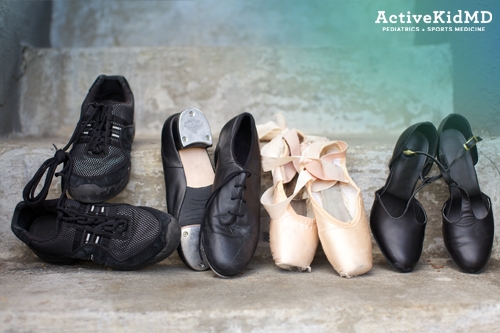When a dancer is told that they need to see a doctor due to an injury or illness, there’s probably quite a bit of fear.
- Fear that doctors will not appreciate the demands of dance.
- Fear that the dancer will be told simply “just stop dancing”.
- Fear that the dancer and his or her family may not know the questions to ask to get the most out of the visit.
It’s ok to be scared and fear is a normal feeling, but how can we work through some of these unknowns?
Here, we share a few tips that can help you prepare and get the most out of your experience with your doctor, physical therapist, or healthcare provider!
BEFORE YOUR VISIT:
 Dress ready to move- and don’t forget your shoes.
Dress ready to move- and don’t forget your shoes.
When going to a medical facility, don’t be afraid to bring pointe shoes, character shoes, and dress in a way that allows you to move comfortably. It is extremely difficult to examine a dancer’s hips and knees if they’re wearing tight jeans. Coming in dance outfits or athletic apparel will allow a more comfortable and complete physical examination.
Have a list of your goals (not instructors, parents, or even fellow dancers).
Come to the visit with an idea of upcoming rehearsals, performances, competitions, intensives, and other events. Ideally, you, as a dancer, should help decide which are the most realistic and important in your recovery journey. Don’t be afraid to speak up and let everyone in the room know your targets. If there is a show coming up soon (like this weekend), have a realistic discussion about risks/benefits of performing and possibly worsening an injury or prolonging recovery.
Don’t be afraid to share some videos.
Be prepared to tell the doctor what movements and techniques cause the most pain.
Now, you may fear that the doctor does not understand or have a clue about dance positions and movements. This is where videos can be quite important. Bring videos of you dancing for a good visual illustration of those movements or techniques that are the most of concern for you.
DURING YOUR VISIT:
Be a student of your own body.
Try to be as accurate as possible when describing where you hurt, the type of pain or discomfort (sharp, burning, stabbing) and what movements make discomfort better or worse. Using a fingertip can be quite helpful in identifying the location of pain. Also be aware of any swelling, numbness, tingling, or other abnormal sensations that should be shared. Don’t limit focus to just a single painful joint. Oftentimes knee pain may be triggered, in part, by limited hip or ankle motion. So, if you are seeing the doctor for a knee injury but your hips are also hurting, speaking up and giving the full story may likely contribute to a fuller recovery. Often, our joints are related to each other so it may help your doctor to build a comprehensive picture of you and your situation.
“Where do you want to take dance and where do you want dance to take you.”
On the same thought chain as defining your goals, an injury isn’t always negative, and is also an opportunity for learning. Injuries can give additional perspective on both short-term and long-term dance commitments. A thoughtfully designed recovery program can make a dancer stronger and more self-aware for the future. Many dancers will credit past injuries as important teaching points that have contributed to a more prolonged and healthier dance career.
Treat medical or therapy visits as an opportunity to grow by being an active participant, and asking, “what do I want to learn” or “what connections did I make today?” to take away/apply for the future.
Ask genuine questions and express yourself – just like you do with your dance.
Share insights about what drives you and develop a true collaborative relationship with your medical team. The more that they know about you, the more they can meet your unique needs.

Most dance injuries do not require absolute removal from all activities, but rather individualized modifications. For example, a dancer with a lower leg stress injury might be able to lightly mark steps, do upper body work, and condition through Pilates or water-based activities. Another dancer with a back injury may have to limit upper body work, lifts, and arabesque position, but can still glide and do lower body foot work.
Ask about telemedicine options.
Many dance medicine providers will allow for telemedicine evaluations. These may not be ideal for an initial visit where a face-to-face interaction is more helpful, but they can be useful for follow up appointments. This may also allow the provider to watch you in a dance, studio, or moving along with the company to get a better idea of your recovery.
AFTER YOUR VISIT:
Build Your Team
This starts with not going to a visit alone. Bring a family member, friend, or other trusted individual to help take notes, ask questions, and digest the information shared at the visit. Building a team also includes asking what other professionals should be involved in your recovery. Ask for referrals to dance specialists for therapy/exercises and if comfortable, give permission for members of your team to speak with each other (and instructors/teachers) as needed.
Continue the Conversation
Support isn’t just about when you see your doctor, therapist, or healthcare professional. If need be, inform your healthcare provider in between visits so they can stay in the know about how to best support you in that moment or perhaps at the next visit.
In conclusion!
Injuries and illnesses can be frightening for dancers. Being better about how we communicate what we’re feeling and experiencing can help take away some of that fear and give more confidence in getting the most out of doctor visits for your overall health and dance career.


